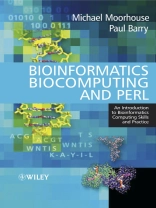Bioinformatics, Biocomputing and Perl presents a modern
introduction to bioinformatics computing skills and practice.
Structuring its presentation around four main areas of study, this
book covers the skills vital to the day-to-day activities of
today’s bioinformatician. Each chapter contains a series of
maxims designed to highlight key points and there are exercises to
supplement and cement the introduced material.
Working with Perl presents an extended tutorial
introduction to programming through Perl, the premier programming
technology of the bioinformatics community. Even though no previous
programming experience is assumed, completing the tutorial equips
the reader with the ability to produce powerful custom programs
with ease.
Working with Data applies the programming skills acquired
to processing a variety of bioinformatics data. In addition to
advice on working with important data stores such as the Protein
Data Bank, SWISS-PROT, EMBL and the Gen Bank, considerable discussion
is devoted to using bioinformatics data to populate relational
database systems. The popular My SQL database is used in all
examples.
Working with the Web presents a discussion of the
Web-based technologies that allow the bioinformatics researcher to
publish both data and applications on the Internet.
Working with Applications shifts gear from creating
custom programs to using them. The tools described include
Clustal-W, EMBOSS, STRIDE, BLAST and Xmgrace. An introduction to
the important Bioperl Project concludes this chapter and rounds off
the book.
Tabla de materias
Preface.
1. Setting the Biological Scene.
2. Setting the Technological Scene.
I: WORKING WITH PERL.
3. The Basics.
4. Places to Put Things.
5. Getting Organised.
6. About Files.
7. Patterns, Patterns and More Patterns.
8. Perl Grabbag.
II: WORKING WITH DATA.
9. Downloading Datasets.
10. The Protein Databank.
11. Non-redundant Datasets.
12. Databases.
13. Databases and Perl.
III: WORKING WITH THE WEB.
14. The Sequence Retrieval System.
15. Web Technologies.
16. Web Automation.
IV: WORKING WITH APPLICATIONS.
17. Tools and Datasets.
18. Applications.
19. Data Visualisation.
20. Introducing Bioperl.
Appendix: A–F.
Index.
Sobre el autor
Michael Moorhouse works as a Bioinformatics Researcher for
Erasmus MC in Rotterdam, The Netherlands. He holds a B.Sc. from
UMIST and an M.Sc. from The University of Manchester. Michael
recently completed a Ph.D. from The University of Birmingham in the
UK. He has been involved in numerous bioinformatics courses
throughout the UK and Netherlands. This is Michael’s first
book.
Paul Barry works as a Lecturer in Computing Science at
The Institute of Technology, Carlow in Ireland. He holds a B.Sc.
from The University of Ulster in Jordanstown, Northern Ireland and
recently completed an M.Sc. from The Institute of Technology, Sligo
in Ireland. He is the author of Programming the Network with
Perl (Wiley, 2002).












